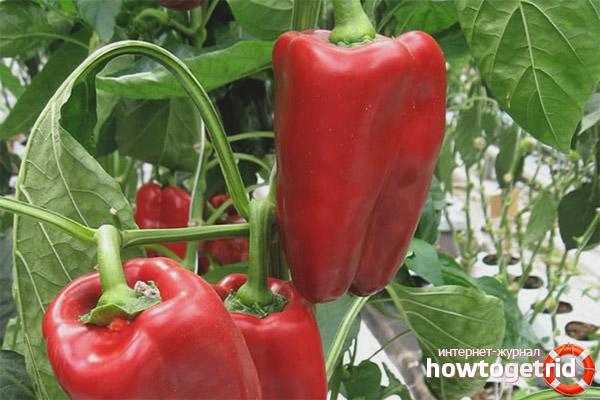The content of the article
In spring and summer, the day feeds the year, so early ripe varieties and hybrids with a friendly return on harvest are appreciated. They are grown only through seedlings, otherwise the advantage in terms is lost. To preserve plants from spring bottom frosts, they are usually covered with a film or planted in a greenhouse. Hybrid Ekaterina F1 perfectly tolerates the vagaries of nature, can grow in open areas, bred taking into account the climate characteristics of central Russia and the northern regions.
Description and benefits of the variety
Bushes reach a height of 75-80 cm, compact with a powerful root system. With regular feeding and observing planting dates, 17-19 fruits are formed on each plant. Pepper is not large in size, on average, the weight is kept at 140-170 g, with a wall thickness of 6.5-7 mm. Color in full ripeness is red, glossy, in technical - light green. The taste of fruits is sweet with a slight acidity, saturated. The pulp is juicy, fleshy, few seeds, located in the petiole region.
Benefits:
- good germination;
- sustainability in tobacco mosaic;
- cultivation in open and closed ground;
- high productivity;
- ovary formation even under adverse weather conditions;
- undemanding to the soil;
- long shelf life.
A stable indicator of productivity is 6 - 7.5 kg per 1 sq.m.
It is worth considering: pepper is suitable for use in fresh and canned form.
Planting, care, top dressing
For an earlier harvest, it is grown only in seedlings, taking into account climatic conditions. Plants are planted in the soil at the age of 60-65 days, 3-4 bushes per 1 sq.m. Since they are quite textured, more frequent planting will obscure neighboring ones, interfering with flowering and fruit growth.
For planting, prepare a soil mixture of peat, turf, a small amount of ash. You can use the purchase option, which the soil has already been adapted for growing vegetables and made basic fertilizers.
Pepper does not tolerate transplantation if planted very densely. Save space is not worth it. It is better to grow a small number of strong plants than a whole shoot of frail seedlings. Therefore, the seeds are planted at a distance of 2 cm and observe row spacings of 5 cm.
Pepper is sensitive to a deficiency or overabundance in the soil of nutrients, micro and macro elements. This can be determined by the condition of the leaves and the general appearance of the plant. Special requirements of the plant for the presence of potassium, phosphorus and nitrogen.
Important: for the correct formation of plants at the seedling stage, compliance with the feeding scheme is required.
If you alternate the application of organic and complex fertilizers, then the plants develop well, and the harvest will be plentiful with good taste.
Attention should be paid to protecting the bushes from pests, especially fleas and aphids. They damage leaves and flowers. It is not difficult to see them, because they are located on the petioles and the outer side of the leaf. On sunny days, crawl to the inside. At the first signs, planting preparations should be treated, if pepper is already approaching full ripeness, then it is better to use alternative methods.
Pepper Ekaterina F1 earned excellent reviews from summer residents and agricultural experts for its taste, productivity and unpretentiousness to growing conditions.
Video: growing pepper from A to Z










Submit